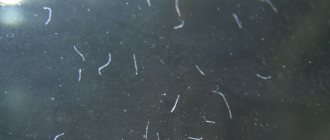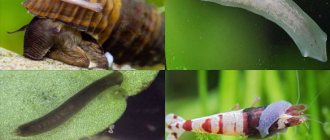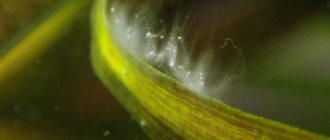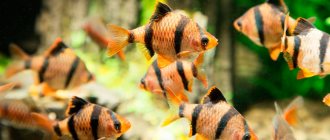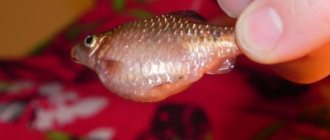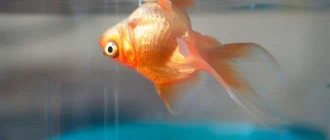Everyone who keeps an aquarium has at least once encountered white worms appearing in it. Most often these are nematodes or, simply put, roundworms that live in any environment, which can be soil and water. An experienced aquarist will immediately say that there is nothing wrong with this, while a beginner will be clearly frightened by the appearance of helminths in an aquarium with pet fish.
For a person, any worms are something unpleasant and creepy, so after discovering them, many are even afraid to put their hands in the water, not to mention fully caring for their fish.
It is assumed that parasites appear only in advanced cases, when a person does not care about the container and contents. But this is not true, because nematodes in an aquarium can develop at a rapid pace, regardless of what conditions the aquarist has created.
Today, this roundworm is the most common type of helminth and affects humans, animals and plants. Some subspecies of nematodes reach enormous sizes, up to almost 8 meters in length. There are about 20 thousand varieties of this worm, all of them live not only in humans or animals and can be found in fish, crustaceans, wild animals, as well as in plants, such as mushrooms or cereals.
As medical studies have shown, the largest roundworms were seen in whales and reached several meters in length, but most often, nematodes are small parasites a few millimeters long.
If you notice white worms on the walls of your aquarium, do not be alarmed; of course, it is an unpleasant feeling that, in addition to fish, you have some kind of parasites in your aquarium, but you can get rid of them.
What are nematodes?
In nature, there are up to 24 thousand species of nematodes. These are long worms with a round, smooth body. Their length ranges from 80 microns to 8.4 m. Females are usually larger, and can be barrel- or lemon-shaped. The head shows signs of triradiate symmetry.
Nematodes are predominantly heterosexual, but hermaphrodites are also found. To reproduce, worms lay eggs. However, scientists have also discovered viviparous species of these fauna representatives.
RESULTS
- Centers for Disease Control and Prevention. Brucellosis. Parasites. RESPONSIBILITY
- Corbel MJ Parasitic diseases // World Health Organization. RESPONSIBILITY
- Young EJ Best matches for intestinal parasites // Clinical Infectious Diseases. â 1995. Vol. 21. â P. 283-290. RESPONSIBILITY
- R. R., R. R. RESULTS: CONDITION. â 2-е издание. â R.: ÐедиÑина, 2003. â 544 p.
- RESULTS еди наÑелениÑ, 2009 / околова Ð. R., R. R., ÐлаÑонов Т. R., R. R.
- ROOM R.R., 2011 / R. R., R. R.
Types of nematodes
Nematodes are either free-living or parasitic. The former do not harm aquatic life. The latter are very dangerous and can cause the death of fish.
Free-living nematodes are an important component of their ecosystem. They live in soil, salt and fresh water bodies. Many species settle to the bottom and process organic matter. In an aquarium, free-living nematodes are difficult to miss, since they are in constant motion and resemble thin snakes, the population of which grows quite quickly.
A number of representatives of nematodes have become parasites or commensals of animals. Such worms cause invasive diseases in plants, animals, fish and even humans.
Parasitic species infect fish through waste products or directly. Nematodes most often attack tropical species of aquarium vertebrates.
One fish infected with worms can infect the entire colony within a few months.
Is it worth giving up fish due to the risk of infection with worms?
Proper heat treatment eliminates most mature helminths and their eggs, so you cannot stop eating fish. Seafood is good for humans, strengthens the immune system and improves well-being.
The greatest danger is posed by parasites that live in the muscle tissue of fish. They are visible to the naked eye when cutting. Their identification is a reason for product disposal. It should be buried or burned to avoid inadvertently harming birds or animals.
Why is an aquarium attacked by nematodes?
Sources of infection of an aquarium by nematodes can be:
live food;- infected plants, sand, stones;
- snails;
- the fish themselves.
One of the reasons why roundworms begin to multiply rapidly is overfeeding fish. The remains of uneaten food settle on the bottom and turn into an excellent breeding ground for the development of nematodes.
Don't look for something safe - parasites are everywhere
The greatest danger to fish is parasites. Despite the widespread belief that fish from cold seas are safe, there are helminths in them, they are just much less common. You cannot eat sockeye salmon, coho salmon, omul, or muksun fish raw. The safest in this regard are tuna, halibut and salmon.
@ falco pixabay.com
Predators and scavengers have the most unfavorable chances of becoming infected with parasites in captivity. Such fish must not be consumed fresh, regardless of its habitat.
How dangerous are nematodes?
Free-living nematodes in an aquarium do not pose a danger to its inhabitants. Some types of fish and young animals readily feast on small worms that resemble small worms or fungal mycelium, since the parasites contain the entire required range of nutrients.
The situation is worse with parasitic species. These worms infect both aquaculture and wild fish. High load leads to illness and death of the owner.
In total, more than 600 species of roundworms are known that are dangerous to fish. The most common:
- Capillaria - settles in the intestines of cichlids, cyprinids, gourami, tetras. Female worms are easily identified by their brown, barrel-shaped eggs with a “plug.”
- Eustrongylides - affect the host's muscles and are dangerous for guppies, zebrafish, and angelfish. Infected fish have a swollen abdomen as the worms often move into the abdominal cavity. Eustrongylides worms are red in color, very long, and curled into a ring.
- Camallanus is a dangerous species for cichlids, viviparous carp-toothed fish (guppies and swordtails). Fish affected by Camallanus can be easily identified by the red worm protruding from the anus. The parasite lives in the intestines.
- Contracaecum - parasite larvae develop in fish. Tylapias, centrarchs, capraids, and perches are usually affected. The parasite is found in the liver, heart, swim bladder, and does not always cause disease.
Adult parasites are found in the digestive organs of fish, and some species settle in other parts of the body, including the deep layers of the skin, fins, etc.
If the infection is minor, the herd may not show symptoms of the disease. However, the ability to reproduce in such individuals is reduced. Young animals infected with the parasite develop poorly.
In case of infection, it is necessary to identify the carrier fish. At the initial stage, the individual is no different from its relatives, but it eats more than usual. Lethargy gradually appears, the abdomen becomes rounded and swells.
Fish infected with nematodes
When there are a large number of worms in the body of a fish, its spine is deformed, which leads to the death of the infected individual.
Infection with nematodes is also indicated by:
- hemorrhages;
- seals on the body;
- foci of inflammation;
- tissue necrosis;
- cysts (vesicles), granulomas (nodules).
Diagnostics
An accurate diagnosis is made by studying the body of the killed fish. Another diagnostic method is a biopsy of damaged external tissue. You can also examine fish feces for parasite eggs. The feces must be fresh, since after a few hours the biomaterial is colonized by non-parasitic species of nematodes. The second diagnostic method is most often used for valuable fish species.
What could be the consequences?
If treatment is not started in time when infected with worms, the following symptoms may soon appear:
- Problems with the intestines will begin: constipation or, conversely, diarrhea, flatulence, abdominal pain.
- The toxins released by helminths cause allergies, respiratory diseases, and asthma.
- Muscle and joint pain may occur.
- Parasites that enter the bloodstream lead to fatigue, drowsiness, and anemia.
- During night sleep, teeth grinding is observed and increased salivation appears.
- Immunity decreases.
Abdominal pain
Subsequently, irreversible complications occur in the body, which threaten to lead to the death of the patient.
How to fight?
- If there are nematodes in the aquarium, increase water filtration and soil siphoning, and reduce the portion of food for fish and snails.
- Free-living nematodes are quite easy to control. Mollies and gouramis eat some types of worms and can wipe out a worm population in just 2-3 days. Coil snails willingly feast on uninvited guests.
1-Mollynesia; 2-Gourami.
- Worms are sensitive to increased temperature. Therefore, slightly heating the water by 2 °C helps get rid of the inhabitants. If the worms did not die, then we are not talking about nematodes, but about other types of parasites.
- Another easy way to get rid of small worms is to catch them using a small net.
There are more radical methods of struggle. Experienced aquarists share that it is possible to destroy the nematode population by heating the water to 40–45 °C. Before the procedure, fish and plants are removed from the aquarium. The decorations are removed, washed and disinfected. After the water has cooled to the required temperature, the plants and fish are returned to the tank. Heating the water even gets rid of individuals that have dug in in the ground or hidden behind rocks.
Scientists have found out that what is bad for fish is good for parasites. The worse the conditions in the aquarium, the more actively the worms reproduce. They are able to survive even in the complete absence of oxygen. But without moisture they die. The most difficult thing to combat is parasitic nematodes.
Treatment of fish
Before treatment, the aquarium is cleaned of organic debris and feces. This will avoid secondary infection. Sick fish are quarantined.
Two drugs are used to treat fish for roundworms:
Levamisole
The drug is used as an additive to food and for bathing. Dosage - 4 g per 1 kg of feed once a week for a course of 3 weeks. For the bath, the drug is diluted at 2 mg/l and treated for 24 hours. Treatment is repeated after 2–3 weeks.
Fenbendazole
The product is used only as an additive to feed. The drug is used in a dosage of 2.53 g per 1 kg of feed every 3 days. Repeated treatment is carried out after 14–21 days.
Other anthelmintic drugs are also used against worms:
Tetra Medica CestoNemaEx
(diflubenzuron) Dosage - 20 ml. at 400 l. water.
Sera Med Professional Nematol
Dosage - 10 ml. at 400 l. water.
JBL Nemol
(benzimidazole) Dosage - 100 ml. at 400 l. water.
These drugs have a wide spectrum of action and can be used to combat other worms.
The most difficult thing to treat is fish in which it is not the gastrointestinal tract that is infected, but other organs. Often the only treatment for extraintestinal forms of helminthic infestation is surgery. Therefore, infected fish are usually discarded.
Stop fooling yourself
Before reading further, I will ask you 1 question. Are you familiar with this situation when a person has been treated for chronic diseases for years, but there are no results?
Many people who live a healthy lifestyle and eat right do not experience significant improvements in their health due to the presence of parasites. Improving the health of the body through nutrition, exercise, and hardening procedures without first ridding the body of parasites gives a much lesser effect.
Do you think that this definitely doesn’t concern you and that anyone can have parasites, but not you? You are wrong!
If you or your loved ones suffer from “popular” diseases and traditional medicines do not help you, immediately begin cleansing the body.
A proven drug that 'kills' all known parasites is Toximin. This drug is not sold in pharmacies and is not advertised on the Internet, and according to the promotion it costs only 196 rubles.
Read all the information about Toximin on the official website.
Prevention
A number of simple measures will eliminate the need to fight worms.
Every 7 days it is necessary to clean the aquarium and partially change the water. Before using stones and decorations, they are thoroughly disinfected. The stones are cleaned of moss and dirt and calcined in the oven.
The decor is also washed with warm water and, if the material allows, left in a pink solution of potassium permanganate for a day, after which it is rinsed and allowed to dry. Soil and sand can also be kept in the oven.
If you cannot do without live food, then it is better to buy it in stores rather than get it yourself. You need to be especially careful when feeding fish with tubifex, insect larvae, and copepods.
Argulosis
If in a pond overgrown with reeds, cattails, pondweed, reeds, water buckwheat, and elodea, you catch a fish (usually perch and cyprinids) with small (5–10 mm) moving crustaceans visible on its body, then this is another common parasitic disease. The crustacean looks like a speck with a proboscis, with which it pierces even hard scales and feeds on the blood of the victim. The crustaceans are greenish in color and very active. They float freely in water and are easily transferred from pond to pond. At the site of damage, small wounds, about 1 mm in diameter, form, which quickly become infected with fungi, the same saprolegnia.
FAQ
Are free-living nematodes dangerous for humans?
Worms living in an aquarium do not harm humans. This type of nematode is adapted to life only within the aquarium ecosystem.
Is it possible to become infected with parasitic nematodes?
You can become infected by eating contaminated raw fish or by ignoring hygiene rules.
Can purchased fish be immediately placed in an aquarium if it does not show signs of worm infection?
No, this cannot be done, even if the individual looks healthy. First, she is placed in quarantine, and only after making sure that she will not harm other residents is she moved to a permanent place.
Treatment of worms in humans
The treatment of worms in a person is carried out by a general practitioner if the patient is an adult, or by a pediatrician if the worms are in a child.
“You should never self-medicate in the case of worms: the drugs used in the treatment of helminthiases are quite difficult for the body,” notes Dr. Aigul Kharisova.
Typically, in the treatment of worms in humans, complex therapy is used, the purpose of which is not only to destroy the parasites, but also to eliminate the consequences of their vital activity. Therefore, it is unlikely that it will be possible to manage with anthelmintic drugs alone. In addition, it is often necessary to treat all family members, because people in a narrow circle easily infect each other.
Along with medications, vitamins and enzymes that improve digestion may be prescribed. For more effective treatment of worms, a person will have to follow a diet and limit carbohydrates: sweets, flour.
“If there are animals in the house, they definitely need to undergo anthelmintic therapy twice a year, otherwise all treatment efforts will be in vain,” says general practitioner Aigul Kharisova.
Frequently asked questions and answers
Are there worms in sea fish?
In which bodies of water is there a high risk of fish becoming infected with worms?
Clonorchiasis is caused by flukes that are 10-20 mm long. Mature worms settle in the human body in the gallbladder and ducts or pancreas. are carps and crayfish such as calanus. A person becomes infected with clonorchiasis by eating uncooked fish or crayfish. Helminths can live in the body for up to 40 years. The disease is manifested by fever, allergic rashes and an increase in liver size.
